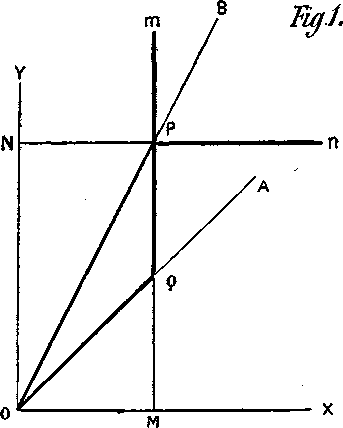610
THE ECONOMIC JOURNAL
particularly deserved by a certain passage leading to what I have
called the second story : where Mill notices the phenomenon of
multiple equilibrium, and says : ‘ It is conceivable that the con-
ditions might be equally satisfied by every numerical rate which
could be supposed.’ This statement appears somewhat incon- ,
sistent with the conception of an equation which Mill has
that cost ; after the trade, she will not be induced to undergo a greater cost for any
amount of linen. The conditions are represented in Fig. 1, where the horizontal
О X denotes yards of cloth, the perpendicular O Y yards of linen. The cost of pro-
ducing cloth and linen in England being the same, the indifference curve of England
is the line O A making with О X an angle of which the tangent is unity (ante).
The demand curve indicated by thick lines is a part of the indifference-curve, viz.
O Q, and a part of the ordinate through M, from Q to infinity ; O M representing
a million yards of cloth. For at the rate of one of linen to one of cloth any point
on O Q may be a point of equilibrium. At that rate England takes 1,000,000 linen
in return for the labour-cost by which 1,000,000 Clothareormightbeproduced;
and it is indifferent to England whether she procures that 1,000,000 of linen by pro-
ducing it all, or by producing any part and obtaining the rest in exchange for cloth,
or by obtaining the whole in exchange for cloth. Thus O Q is part of the demand-
curve. At the rate of exchange of more than one of linen to one of cloth England
is ready to take in return for O M of cloth any amount greater than M Q of linen.
Thus Q m is the continuation of the demand-curve. By parity O B is the indiffer-
ence-curve of Germany, O N being = 2 O M. Also O P and P n form the demand-
curve of Germany. Accordingly the point of equilibrium is at P, on the indiffer-
ence-curve of Germany ; which corresponds to MiITs conclusion.

A (2). Inthe next case (Ib., par. 4) ‘the cloth which Germanyhadheretofore
required was 800,000 yards only, equivalent at the German cost of production to
1,600,000 yards of linen. ’ This case is represented by Fig. 2 where O N = 1,600,000 ;
and the demand-curve of Germany is now OS Sn, while the demand-curve of
More intriguing information
1. Fertility in Developing Countries2. Revisiting The Bell Curve Debate Regarding the Effects of Cognitive Ability on Wages
3. Passing the burden: corporate tax incidence in open economies
4. The name is absent
5. EXECUTIVE SUMMARY
6. Credit Market Competition and Capital Regulation
7. A Rational Analysis of Alternating Search and Reflection Strategies in Problem Solving
8. Endogenous Determination of FDI Growth and Economic Growth:The OECD Case
9. The name is absent
10. Running head: CHILDREN'S ATTRIBUTIONS OF BELIEFS